My Ferguson A10RWH portable

I found this wee portable at the coup - my flatmate and I had driven down to chuck a load of rotten floor panels from our bathroom (hashtag just previous owner things) and I saw they had a shipping container for electronics. I stuck my head in (of course) and behind a load of modern tellys I spotted this wee beauty. Small enough that I was able to smuggle out of the container back to the car!!!! 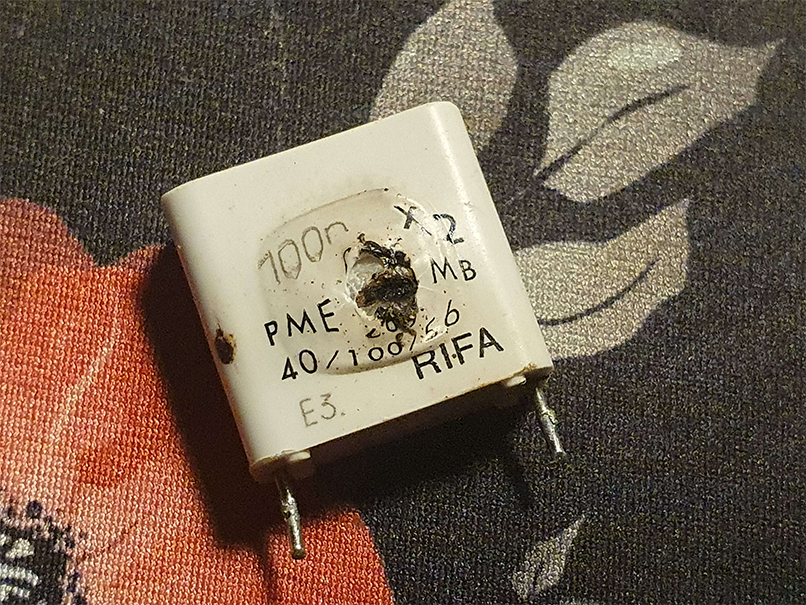 The actual repairs were superficial at first - the cool curved transparency in front of the screen had been scuffed in the dump so I polished it back up and pretty much just plugged it in. In the picture above you can see me testing it out with the only RF input I had to hand at the time, my Acorn Electron. All was well for ages until, to the shock of absolutely nobody, a ~35yo dry cap blew in the power supply and absolutely STUNK the entire flat out. I was NOT popular hahaha. After performing an autopsy and digging the offending article out (pictured right) I was able to make out just enough surviving details on the cap to find a replacement from ANOTHER telly I had stripped for parts. It now runs pretty much perfectly and I have it sitting on my wee media stack in the living room, waiting for a better home. It's turned out really useful as a wee portable for testing other kit, and it just looks beautiful imo.
The actual repairs were superficial at first - the cool curved transparency in front of the screen had been scuffed in the dump so I polished it back up and pretty much just plugged it in. In the picture above you can see me testing it out with the only RF input I had to hand at the time, my Acorn Electron. All was well for ages until, to the shock of absolutely nobody, a ~35yo dry cap blew in the power supply and absolutely STUNK the entire flat out. I was NOT popular hahaha. After performing an autopsy and digging the offending article out (pictured right) I was able to make out just enough surviving details on the cap to find a replacement from ANOTHER telly I had stripped for parts. It now runs pretty much perfectly and I have it sitting on my wee media stack in the living room, waiting for a better home. It's turned out really useful as a wee portable for testing other kit, and it just looks beautiful imo.
There isn't a huge amount of information about this particular model out there (that I could find, I'm sure some AV mega nerd will happily correct me!) but there's a few wee clues. It runs off 12v or mains, so I think it's safe to assume it was marketed at peeps with caravans alongside normal portable use. I haven't tried it on 12v right enough! I know they originally came with remotes - I don't have one given I found it in a dump - and that along with the fact it has mounting holes on the bottom gives a pretty clear mental image of it being mounted on a swivel up on the wall of some late 80s bedroom. If you're interested, RetroGamerVX posted a video review with a bit more detail :)
Fi-cord 2021-A
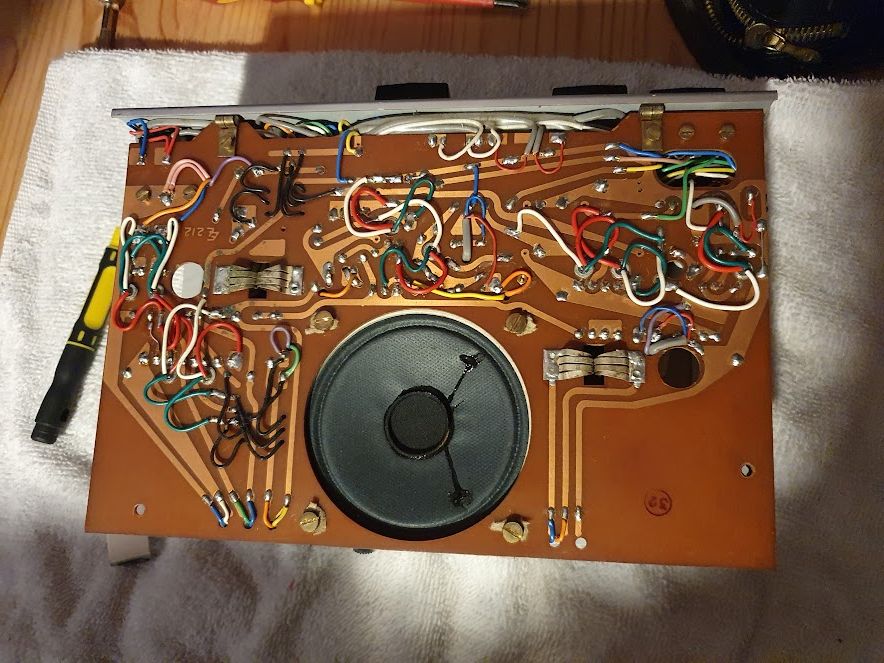
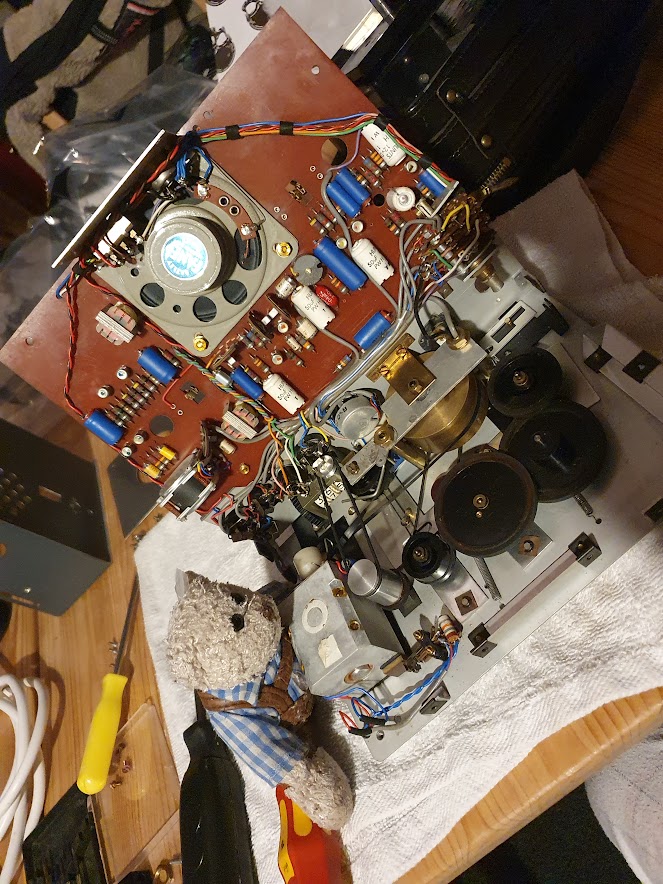 I found the Fi-Cord 202A reel to reel recorder at a car boot - I honestly could not believe my eyes when I saw it lying on the manky ground at a guys stall underneath a load of 2010s audio equipment. I asked him about it and he didn't know what it was (always a Good Sign) so he said "would you give me a fiver for it?" I hummed and hawed theatrically for all of 5 femtoseconds and bought it. It came with the leather carry case and the original leaflet - it even still had the last reel in it!!!! The main bummer is that it did NOT come with the mains adapter (a stank ass proprietary cable ofc) or the battery packs. This has turned into a GIANT headache, because powering this thing is WAY more complicated than I anticipated. The battery packs acted as feet for the unit when it was in a desktop arrangement (you can see pictures of it at the radio museum website) and connected to the machine through these really weird prongs - you can see the female ends exposed in the top picture of the very bonny circuit board, they're the weird goatse lookin metal brush contacts. These are the ONLY point of electrical contact between the battery packs and the unit itself, everything else is just for registration. After a lot (really a lot) of fiddling around I've found out why they cared so much about registration - the outside brush is positive and the inside brush is negative on each side. They REALLY didn't want you attaching the battery the wrong way round!!! After finding the original maintenance manual with circuit diagrams, it turns out that one pack powered the motor and the other powered the amp. According to the marketing blurb, this was intended to eliminate DC hum, which is a pretty interesting idea.
I found the Fi-Cord 202A reel to reel recorder at a car boot - I honestly could not believe my eyes when I saw it lying on the manky ground at a guys stall underneath a load of 2010s audio equipment. I asked him about it and he didn't know what it was (always a Good Sign) so he said "would you give me a fiver for it?" I hummed and hawed theatrically for all of 5 femtoseconds and bought it. It came with the leather carry case and the original leaflet - it even still had the last reel in it!!!! The main bummer is that it did NOT come with the mains adapter (a stank ass proprietary cable ofc) or the battery packs. This has turned into a GIANT headache, because powering this thing is WAY more complicated than I anticipated. The battery packs acted as feet for the unit when it was in a desktop arrangement (you can see pictures of it at the radio museum website) and connected to the machine through these really weird prongs - you can see the female ends exposed in the top picture of the very bonny circuit board, they're the weird goatse lookin metal brush contacts. These are the ONLY point of electrical contact between the battery packs and the unit itself, everything else is just for registration. After a lot (really a lot) of fiddling around I've found out why they cared so much about registration - the outside brush is positive and the inside brush is negative on each side. They REALLY didn't want you attaching the battery the wrong way round!!! After finding the original maintenance manual with circuit diagrams, it turns out that one pack powered the motor and the other powered the amp. According to the marketing blurb, this was intended to eliminate DC hum, which is a pretty interesting idea.
One of the features of the 202-A is a battery meter - I've built battery packs to match the spec and hooked them directly to the terminals but the meter hasn't even flickered. My next angle of attack is going to be the mains adapter. it takes 12v DC (again, from the technical manual) and I'm fairly confident I should be able to build a life threateningly scary adapter to test it out by mangling a DIN plug. This is an on again off again project I dip into occasionally, so either I will post great my great success and start working on the mechanics (which are actually all in really good order and will probably just want a few new belts) or you will read my obituary and know I died of electric.
Chronological Fantasy Map Generation
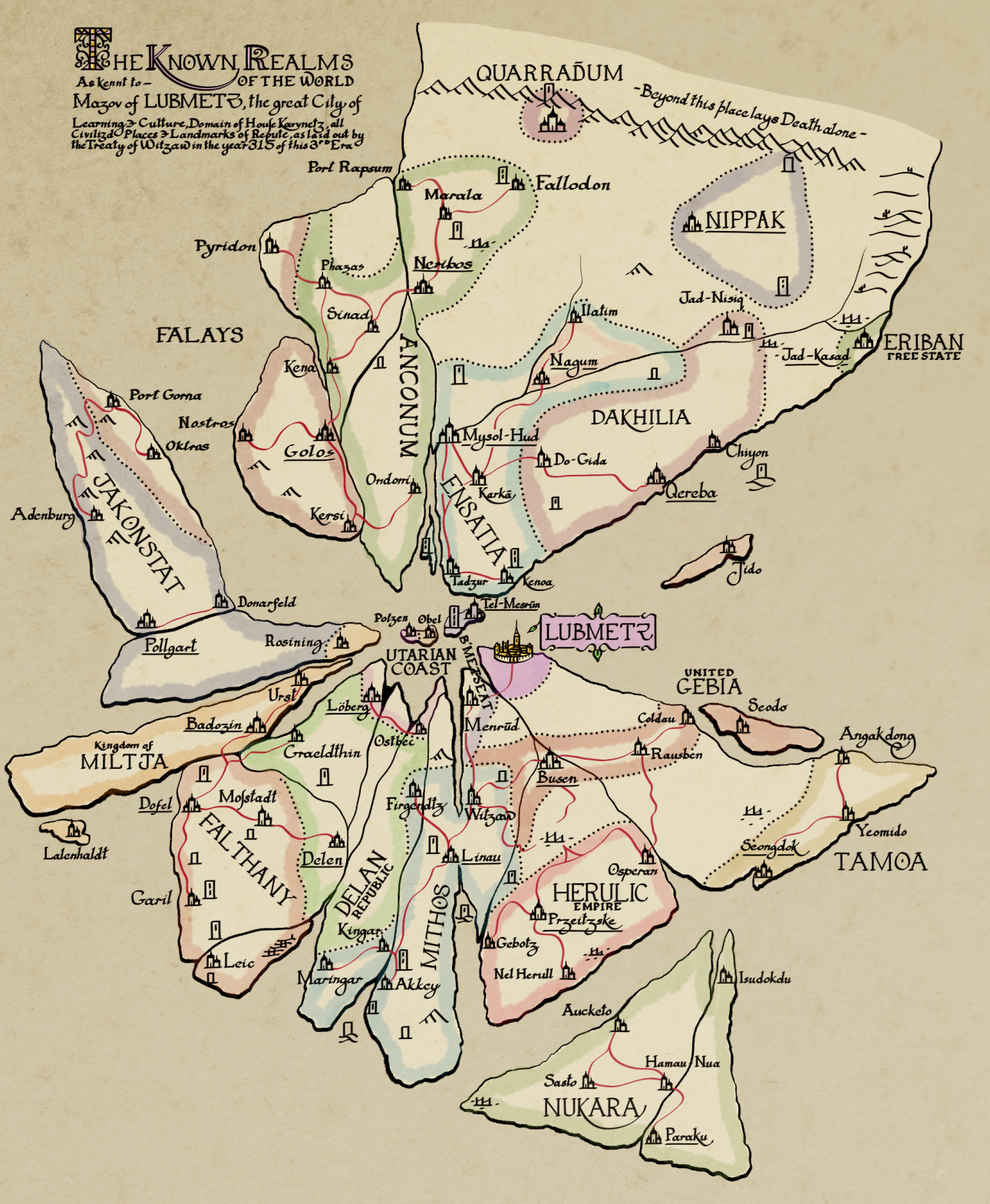
This is a map I made for a dnd fantasy setting. I wanted to try a sort of ~holistic~ worldbuilding strategy - giving myself cultures, languages, cities, settlements, ruins etc by running through the settings history. Maybe the best way to explain it is that I was trying to do what dwarf fortress does when you start a new game. 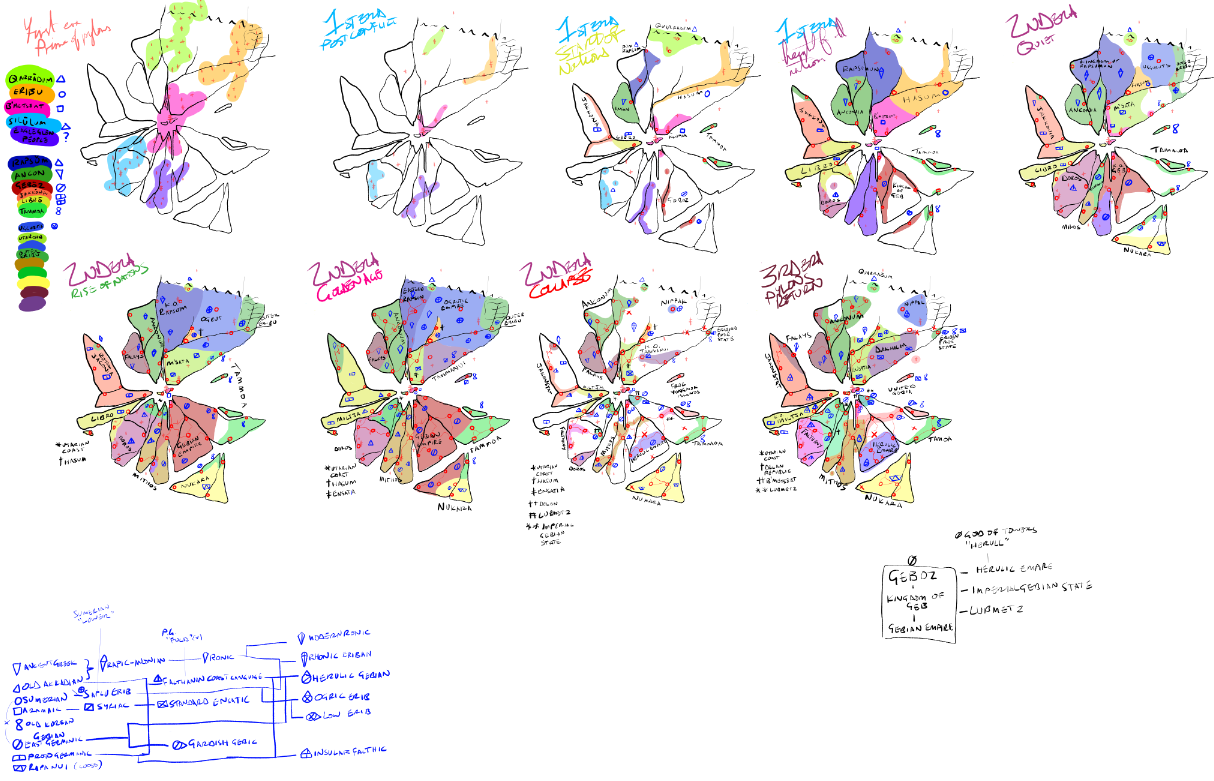 You can see the stages I went through on the right here. I wanted to generate the terrain in a capital M Magic way, so it would be geologically unrealistic, so I started with a photo of a broken bit of glass. In the setting, giant towers (I called them pylons for flavour) were erected by Olden Times Wizards along fractal patterns - these were fractals I generated by looping footage of a TV screen through itself. Five societies form around the pylons, which allow instant teleportation and loads of cheap magic energy. I really liked the idea of what a society like that would look like - particularly the idea that they would have no roads or shipping. The pylons stop working and the civilisations collapse and become super isolated around their old settlements, because the infrastructure to connect them doesn't exist. Different societies rise and fall from that point, with different belief systems and languages, until eventually in the "current day" - when players are meant to start - the pylons start turning back on after a few thousand years of absence.
You can see the stages I went through on the right here. I wanted to generate the terrain in a capital M Magic way, so it would be geologically unrealistic, so I started with a photo of a broken bit of glass. In the setting, giant towers (I called them pylons for flavour) were erected by Olden Times Wizards along fractal patterns - these were fractals I generated by looping footage of a TV screen through itself. Five societies form around the pylons, which allow instant teleportation and loads of cheap magic energy. I really liked the idea of what a society like that would look like - particularly the idea that they would have no roads or shipping. The pylons stop working and the civilisations collapse and become super isolated around their old settlements, because the infrastructure to connect them doesn't exist. Different societies rise and fall from that point, with different belief systems and languages, until eventually in the "current day" - when players are meant to start - the pylons start turning back on after a few thousand years of absence.
It was a really fun writing exercise, particularly figuring out fun ways that neighbouring cultures might adapt to each other. In traditional dnd style I have, ofc, never actually run a game in the setting, but maybe one day. It feels really cool to be able to look at the map and straight away just know what sort of quest hooks are lying around, and what kind of people might live there. If you're interested in this kind of stuff you should give it a go! It took over my life for like two days straight, but if your brain chemicals are a bit normal you probably wouldn't need to go that hard.

 The actual repairs were superficial at first - the cool curved transparency in front of the screen had been scuffed in the dump so I polished it back up and pretty much just plugged it in. In the picture above you can see me testing it out with the only RF input I had to hand at the time, my Acorn Electron. All was well for ages until, to the shock of absolutely nobody, a ~35yo dry cap blew in the power supply and absolutely STUNK the entire flat out. I was NOT popular hahaha. After performing an autopsy and digging the offending article out (pictured right) I was able to make out just enough surviving details on the cap to find a replacement from ANOTHER telly I had stripped for parts. It now runs pretty much perfectly and I have it sitting on my wee media stack in the living room, waiting for a better home. It's turned out really useful as a wee portable for testing other kit, and it just looks beautiful imo.
The actual repairs were superficial at first - the cool curved transparency in front of the screen had been scuffed in the dump so I polished it back up and pretty much just plugged it in. In the picture above you can see me testing it out with the only RF input I had to hand at the time, my Acorn Electron. All was well for ages until, to the shock of absolutely nobody, a ~35yo dry cap blew in the power supply and absolutely STUNK the entire flat out. I was NOT popular hahaha. After performing an autopsy and digging the offending article out (pictured right) I was able to make out just enough surviving details on the cap to find a replacement from ANOTHER telly I had stripped for parts. It now runs pretty much perfectly and I have it sitting on my wee media stack in the living room, waiting for a better home. It's turned out really useful as a wee portable for testing other kit, and it just looks beautiful imo.

 I found the Fi-Cord 202A reel to reel recorder at a car boot - I honestly could not believe my eyes when I saw it lying on the manky ground at a guys stall underneath a load of 2010s audio equipment. I asked him about it and he didn't know what it was (always a Good Sign) so he said "would you give me a fiver for it?" I hummed and hawed theatrically for all of 5 femtoseconds and bought it. It came with the leather carry case and the original leaflet - it even still had the last reel in it!!!! The main bummer is that it did NOT come with the mains adapter (a stank ass proprietary cable ofc) or the battery packs. This has turned into a GIANT headache, because powering this thing is WAY more complicated than I anticipated. The battery packs acted as feet for the unit when it was in a desktop arrangement (you can see pictures of it at the
I found the Fi-Cord 202A reel to reel recorder at a car boot - I honestly could not believe my eyes when I saw it lying on the manky ground at a guys stall underneath a load of 2010s audio equipment. I asked him about it and he didn't know what it was (always a Good Sign) so he said "would you give me a fiver for it?" I hummed and hawed theatrically for all of 5 femtoseconds and bought it. It came with the leather carry case and the original leaflet - it even still had the last reel in it!!!! The main bummer is that it did NOT come with the mains adapter (a stank ass proprietary cable ofc) or the battery packs. This has turned into a GIANT headache, because powering this thing is WAY more complicated than I anticipated. The battery packs acted as feet for the unit when it was in a desktop arrangement (you can see pictures of it at the 